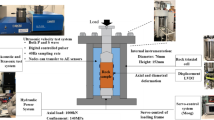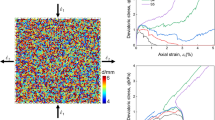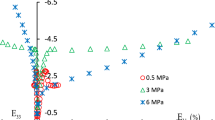Abstract
The dynamic ‘overstress’, i.e., the apparent increase of strength of concrete at very high strain rates (10–\(10^{6}\)/s) experienced in projectile impact and penetration, has recently been explained by a new theory with partial analogy to turbulence. The increase is attributed to comminution of concrete driven by the release of local kinetic energy of the shear strain rate field of forming fragments which, in projectile impact problems, exceeds the strain energy of the fragments by orders of magnitude. This theory gives the particle size distribution and the additional local kinetic energy density, \(\Delta K\), proportional to the deviatoric strain rate square. To match test results, \(\Delta K\) must be dissipated during finite element simulations of impact. In previous simulations, \(\Delta K\) was, at first, dissipated by an artificial equivalent viscosity (not empirical but predicted by the theory). Later it was found that dissipation by upscaling material tensile strength is equally effective. This theoretically justified upscaling is adopted here since it is more realistic when microplane constitutive model M7 for fracturing damage in concrete is used. All artificial damping is eliminated from the computer program. While previous simulations with the comminution theory were limited to orthogonal impacts, and only the cases of penetration of slabs of various thickness by projectile of one velocity and penetration depths for different velocities, the present study also analyzes further test data on oblique impacts at various impact angles up to \(35^\circ \), and on the exit velocities and penetration depths of projectiles of different velocities. For each test series on one and the same concrete, the material parameters are calibrated on one test and then, using the same parameters, all the other tests are predicted. All the predictions of exit velocities and penetration depths of projectiles, as well as entry and exit craters, are quite accurate.





Similar content being viewed by others
References
Bažant ZP, Caner FC (2013) Comminution of solids caused by kinetic energy of high shear strain rate, with implications for impact, shock, and shale fracturing. Proc Natl Acad Sci 110(48):19291–19294
Bažant ZP, Caner FC (2014) Impact comminution of solids due to local kinetic energy of high shear strain rate: I. Continuum theory and turbulence analogy. J Mech Phys Solids 64:223–235
Bažant ZP, Jirásek M (2018) Creep and hygrothermal effects in concrete structures. Springer, Dordrecht
Bažant ZP, Li Y-N (1997) Cohesive crack with rate-dependent opening and viscoelasticity: I. Mathematical model and scaling. Int J Fract 86(3):247–265
Bažant ZP, Su Y (2015) Impact comminution of solids due to progressive crack growth driven by kinetic energy of high-rate shear. J Appl Mech 82(3):031007
Buzaud E, Laurensou R, Darrigade A, Belouet P, Lissayou C (1999) Hard target defeat: an analysis of reinforced concrete perforation process. In The 9th international symposium on interaction of the effects of munitions with structures, Berlin, Germany (pp 3–7)
Bažant ZP, Caner FC, Adley MD, Akers SA (2000) Fracturing rate effect and creep in microplane model for dynamics. J Eng Mech ASCE 126(9):962–970
Bažant ZP, Caner FC, Carol I, Adley MD, Akers SA (2000) Microplane model M4 for concrete. I: formulation with work-conjugate deviatoric stress. J Eng Mech 126(9):944–953
Caner FC, Bažant ZP (2012) Microplane model M7 for plain concrete. I: formulation. J Eng Mech 139(12):1714–1723
Caner FC, Bažant ZP (2014) Impact comminution of solids due to local kinetic energy of high shear strain rate: II-Microplane model and verification. J Mech Phys Solids 64:236–248
Cargile JD (1999) Development of a constitutive model for numerical simulation of projectile penetration into brittle geomaterials (No. WES/TR/SL-99-11). Army Engineer Waterways Experiment Station Vicksburg MS Engineer Research and Development Center
Fan SC, Zhou XQ (2003) Constitutive model for reinforced concrete against penetration. Final Report. PTRC-CSE/DSO/2000.01, Protective Technology Research Centre, School of Civil and Structural Engineering. Singapore: Nanyang Technological University
Feng J, Yao W, Li W, Li W (2017) Lattice discrete particle modeling of plain concrete perforation responses. Int J Impact Eng 109:39–51
Feng J, Song M, Sun W, Wang L, Li W, Li W (2018) Thick plain concrete targets subjected to high speed penetration of 30CrMnSiNi2A steel projectiles: tests and analyses. Int J Impact Eng 122:305–317
Frank AO, Adley MD, Danielson KT, McDevitt HS Jr (2012) The high-rate brittle microplane concrete model: part II: application to projectile perforation of concrete slabs. Comput Concr 9(4):311–325
Hanchak SJ, Forrestal MJ, Young ER, Ehrgott JQ (1992) Perforation of concrete slabs with 48 MPa (7 ksi) and 140 MPa (20 ksi) unconfined compressive strengths. Int J Impact Eng 12(1):1–7
Kirane K, Su Y, Bažant ZP (2015) Strain-rate-dependent microplane model for high-rate comminution of concrete under impact based on kinetic energy release theory. Proc R Soc A 471(2182):20150535
Liu Y, Ma A, Huang F (2009) Numerical simulations of oblique-angle penetration by deformable projectiles into concrete targets. Int J Impact Eng 36(3):438–446
Ožbolt J, Sharma A (2011) Numerical simulation of reinforced concrete beams with different shear reinforcements under dynamic impact loads. Int J Impact Eng 38(12):940–950
Su Y, Bažant ZP, Zhao Y, Salviato M, Kirane K (2015) Viscous energy dissipation of kinetic energy of particles comminuted by high-rate shearing in projectile penetration, with potential ramification to gas shale. Int J Fract 193(1):77–85
Smith M (2009) ABAQUS/Standard User’s Manual, Version 6.9. Simulia, Providence, RI
Travaš V, Ožbolt J, Kožar I (2009) Failure of plain concrete beam at impact load: 3D finite element analysis. Int J Fract 160(1):31
Acknowledgements
Funding under ARO Grant W911NF-15-101240 to Northwestern University is gratefully acknowledged.
Author information
Authors and Affiliations
Corresponding author
Additional information
Publisher's Note
Springer Nature remains neutral with regard to jurisdictional claims in published maps and institutional affiliations.
Rights and permissions
About this article
Cite this article
Luo, W., Chau, V.T. & Bažant, Z.P. Effect of high-rate dynamic comminution on penetration of projectiles of various velocities and impact angles into concrete. Int J Fract 216, 211–221 (2019). https://doi.org/10.1007/s10704-019-00354-0
Received:
Accepted:
Published:
Issue Date:
DOI: https://doi.org/10.1007/s10704-019-00354-0




